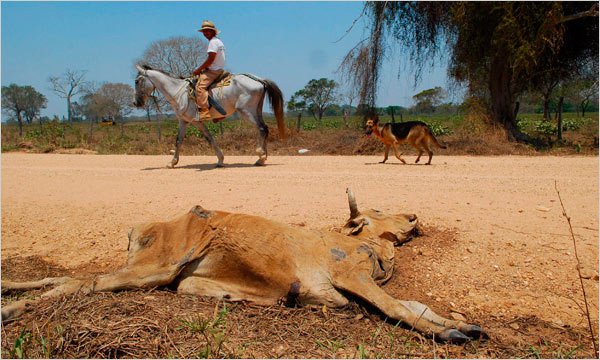
|  |  |  Editorials | Environmental | September 2009 Editorials | Environmental | September 2009  
Mexico Now Enduring Worst Drought in Years
 Elisabeth Malkin - New York Times Elisabeth Malkin - New York Times
go to original
September 13, 2009


| | A farmer rides past a carcass in Tabasco State, which has lost about 7,000 animals. (Jaime Avalos/European Pressphoto Agency) |  |
Mexico City — As the end of the four-month rainy season approaches here in Mexico City, it has finally begun to rain. But the daily downpours, which have overwhelmed the city’s drainage network and flooded subway stations, arrived too late.

Mexico is enduring its worst drought in six decades. Crops are drying up in the fields and water is being rationed in the capital. Residents of poor neighborhoods have hijacked water trucks, and there are other signs of social tensions building.

El Niño, a weather pattern that warms water in the Pacific Ocean and leads to changing weather around the Pacific Basin, is causing the drought, Mexican officials say.

The rainy season typically begins here in June. Rain falls almost daily in most of the country, irrigating the spring planting and filling reservoirs before the dry months. But this year, the first three months of the rainy season were dry. Officials warned that the reservoirs were falling to dangerously low levels.

Some of Mexico’s neighbors have been grappling with similar problems. Guatemala declared “a state of calamity” last week, because the drought has caused shortages of staples like corn and beans. The government plans to deliver food packages to 400,000 families, Reuters reported.

In Mexico, almost 40 percent of the farm land inspected by the government has been affected by the drought, causing shortfalls in the harvests of corn, beans, wheat and sorghum. The Mexican government is spending more than $100 million to buy emergency crop insurance and to dispense direct aid to farmers.

The drought has forced the 20 million residents of Mexico City and its suburbs to confront the vulnerability of their water supply.

The Aztecs built Mexico City, or Tenochtitlán, on an island within a network of shallow lakes. Dykes and canals regulated the flow of water across the vast basin and held back floodwaters.

But the Spanish conquerors set about draining the lakes, and a century ago, the city began to extract water from wells drilled to the water table below. About 70 percent of Mexico City’s water is now pumped out of the aquifer at a rate more than twice as fast as rainfall is able to replenish it.

The other 30 percent of the city’s water is pumped — uphill — from reservoirs 80 miles to the west. As the level in those reservoirs, which are known as the Cutzamala system, was depleted this spring, the city began to restrict water supply in different areas for several days at a time.

The city also began to exhort residents to save water, recommending that they install low-flow showerheads (city officials even handed out a few hundred in poor neighborhoods), fix leaky faucets and check for leaks in toilets and cisterns.

As much as a third of the city’s water supply is lost to leaks, in homes and in pipelines.

The city government heavily subsidizes the cost of water, and Ramón Aguirre, the official in charge of the water supply, said last month that he would lobby the city assembly to drop the subsidy for large consumers. Households pay only 15 percent of what it costs to supply their water.

On the wealthy west side of Mexico City, green lawns and shiny cars are evidence of how much water households use. A study by the National Polytechnic Institute estimated that the city’s wealthy households consumed four to fives times as much water as poor households on the city’s east side. In many poor neighborhoods, the water supply has been cut off frequently, and many people start lining up at 4 a.m. to ask for water trucks to fill tanks in their houses.

Last week, after the most intense downpour in ten years, reporters immediately asked Mr. Aguirre whether all the rain would ease the shortage.

But it turned out that nature had played a trick. For the rain to enhance the water supply, it had to fall to the west of Mexico City, over the mountains where the reservoirs of the Cutzamala system were built. Instead, the rain fell on the city’s streets, got swept down into the drains, piped to the city’s north and eventually emptied into the Gulf of Mexico.

“It would be difficult for a few weeks of rain to compensate for months of drought,” Mr. Aguirre said. “Even though they are welcome.” |

 |
|  |



